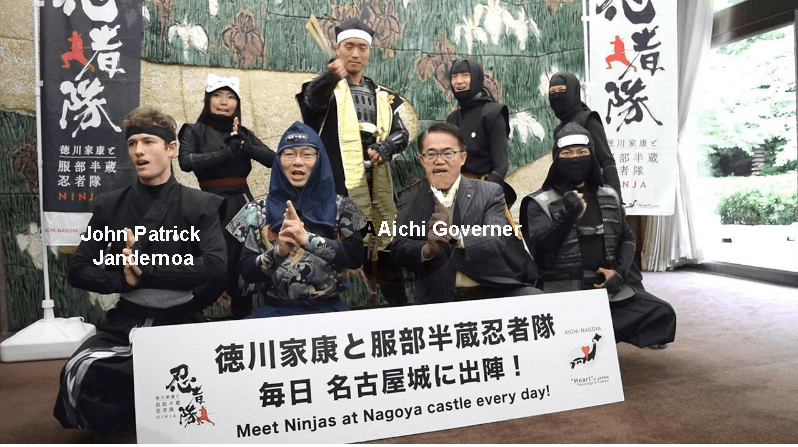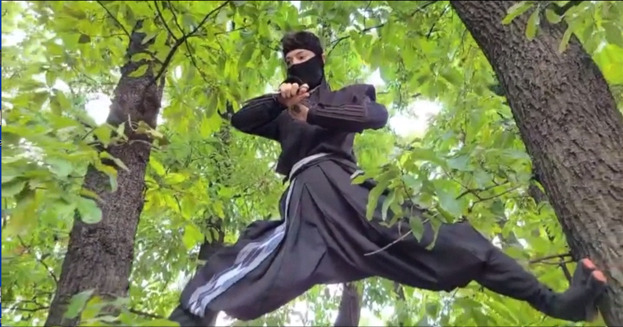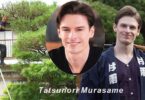Hello how are you?
Following the blog of the basic concepts of ninjas which I posted a couple of days ago, we meet an American young man who has come to Japan to train in the art of ninjutsu, inspired by ninjas.
He is currently studying the Japanese language and martial arts, and he hopes to one day become a ninja himself.
An American ninja in Nagoya
A ninja squad here has welcomed on board an American man known for both his physical prowess and intuitive sensibility.
John Patrick Jandernoa, 26, from Michigan, officially joined the “Tokugawa Ieyasu and Hattori Hanzo Ninja Squad” as “Satori the Soul Seer.”
He is the second non-Japanese member to join since the squad’s inception in 2015 to promote tourism in Aichi Prefecture.

“I’ve been interested in ninja since I was a child,” he said. “Ninja are super cool.”
Jandernoa said he gained knowledge about the feudal-era secret agents through anime and other media and learned about the squad when he traveled to Japan during his college days.
He attended a Japanese language school in Japan after graduation and threw his shuriken ninja stars into the ring to join the group.
Jandernoa was recognized for his enthusiasm and won a spot on the team through an audition held in March.
There are likely very few people alive today who can lay claim to being a professional ninja, but John Patrick Jandernoa is one of them.
While it’s not the kind of profession you’d stumble upon while job hunting in Japan, it was on a whim that the American youth who admired ninja decided to give it a shot.

When auditions rolled around at the end of last year, Jandernoa successfully battled it out against 20 international applicants for a spot as one of the five ninjas in the Hattori Hanzo troupe. (The original Hanzo was a famous samurai who lived from 1542 to 1596 and who is referred to in many forms of pop culture.)
He and five other members visited Aichi Governor Hideaki Omura on June 4 to display their acrobatic performances.
The squad also performed at Chubu Airport on June 13 to introduce the new lineup. It will continue to give performances at Nagoya Castle and elsewhere to promote “samurai-themed tourism” in Aichi Prefecture, the home of Japan’s three great warlords: Oda Nobunaga, Toyotomi Hideyoshi and Tokugawa Ieyasu.

History of Ninja
Ninjas were covert agents, mercenaries, or guerrilla warfare experts in feudal Japan who specialized in siege and infiltration, ambush, reconnaissance, espionage, deception, and later bodyguarding1. They were highly-trained in the martial arts, especially ninjutsu or ‘the art of the ninja.
The origins of ninjas are shrouded in mystery and myth, but historians believe that they first emerged in the 15th century during Japan’s Warring States period.
This was a time of political instability and warfare, with various feudal lords vying for power and territory.
Some historians also suggest that the ancient ninjas may have been yamabushi (“mountain priests”) who adapted the Sonshi, a Chinese martial arts manual, to their own purposes.
Ninjas were known for their use of disguises, deception, and projectile weapons such as shuriken (throwing stars) and blowguns.
Please see his and ninja squads’performance.
They did not enjoy the high reputation that samurai warriors acquired for being chivalrous and courageous.
They were often employed by samurai lords as spies, assassins, or saboteurs.
Ninjas faded into obscurity after the unification of Japan under the Tokugawa shogunate in the 17th century.
However, they became a topic of popular imagination and legend in later periods, where they were associated with legendary abilities such as invisibility, walking on water and control over natural elements1.
Effort Toward Glory

Tapping into the past: John Patrick Jandernoa has had to learn to move like a ninja for his new job, but he has also had to learn the skills of a modern-day media personality by making TV appearances and interacting with fans.
Local governments and tourism organizations have been riding the wave of endless fascination with the stealthy feudal warriors, which still resonates with visitors both at home and abroad.
In a promotional stunt at the end of last year, petitioners dressed in ninja costumes “sneaked” into the office of Prime Minister Shinzo Abe to request his support in promoting ninja culture to tourists during the 2019 Rugby World Cup and the 2020 Tokyo Olympics.
Earlier this year, flight personnel and cleaning crew at Chubu airport in Tokoname, Aichi Prefecture, dressed up in ninja attire as part of a local promotional campaign for National Ninja Day on Feb. 22.

While such stereotypes can spark initial interest in the culture, Jandernoa is hoping he can help separate fact from fiction.
“I’ve been studying about actual ninjas, and learning the difference between what my prior image of a ninja was versus what a real ninja is,” he says.
What he hopes to channel most in his performances, though, is the ninja mindset: “It’s the attitude of doing whatever it takes to succeed in a mission, never giving up, and always having that fiery determination to keep moving forward and be disciplined.”
Since landing the role, Jandernoa has adopted a training ritual that, from a layperson’s point of view, looks nearly as rigorous and physically demanding as that of the historical ninjas he depicts on stage.
Initially, he trained for hours every day to be able to execute his swordsmanship and acrobatic stunts in a way that is historically faithful.
“It was pretty intense, especially the first few weeks,” he recalls. “Now that I’ve actually had my debut, it’s a little bit more hectic.”

Flipping out: John Patrick Jandernoa has been able to use the skills he learned as a dancer in the ninja stage show he acts in
Arguably, however, some of Jandernoa’s biggest fans aren’t in Japan but back home in Michigan.
“All of my friends and family were very supportive and happy to hear that I was adventuring to Japan to pursue my dreams,” he says. “They all had faith in me and told me that I would succeed.”
While his friends and family have yet to see Jandernoa in action as Satori, they’re hoping to make the visit to watch him kick his career goals, as well as a few ninja enemies along the way.
Finally, please enjoy his video,
In the end, I would like to send cheers for his future success.
I also would like you to visit “Ninja University Grants First-ever Ninja Studies Degree“, thanks





